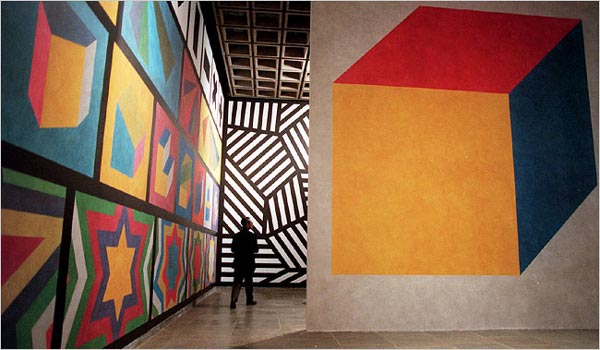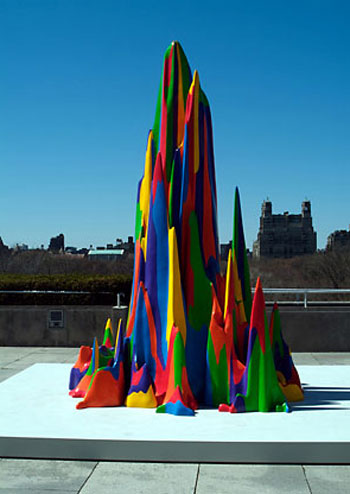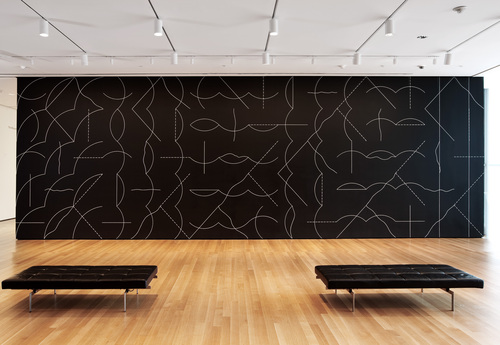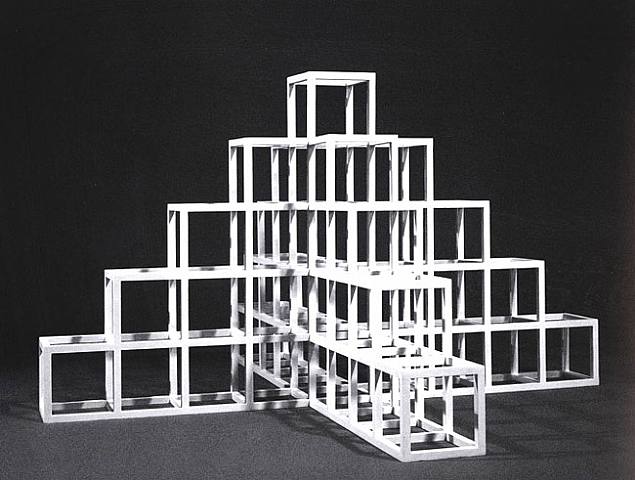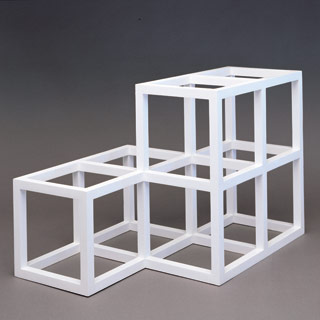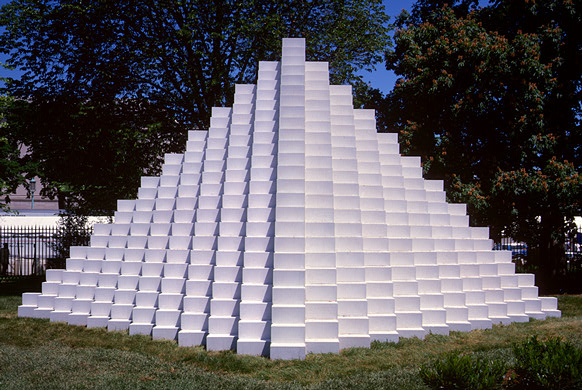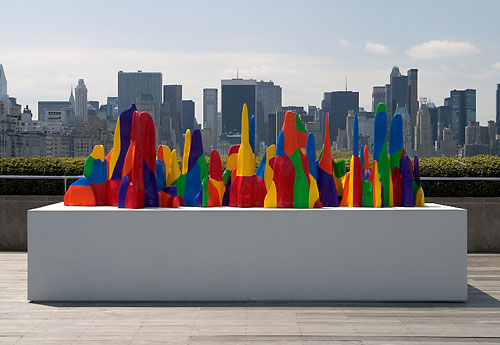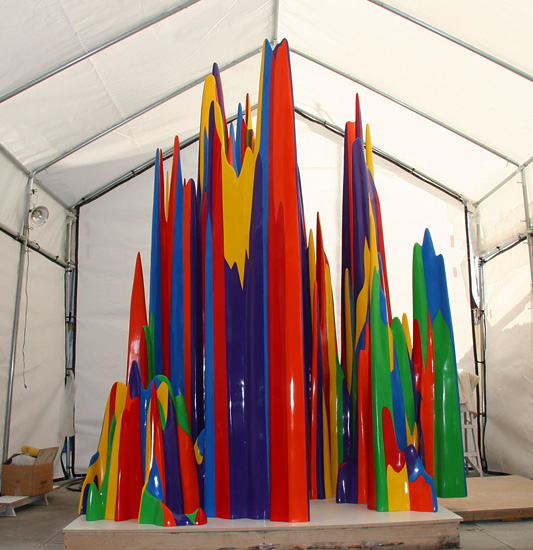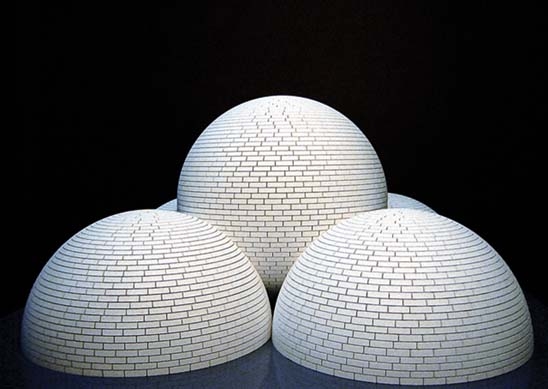<Back to Index>
- Painter and Sculptor Solomon "Sol" LeWitt, 1928
PAGE SPONSOR
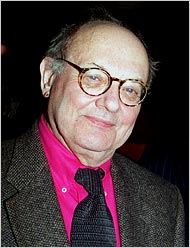
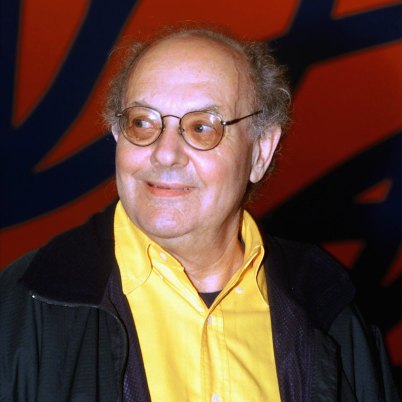
Solomon "Sol" LeWitt (September 9, 1928 – April 8, 2007) was an American artist linked to various movements, including Conceptual art and Minimalism.
LeWitt came to fame in the late 1960s with his wall drawings and "structures" (a term he preferred instead of "sculptures") but was prolific in a wide range of media including drawing, printmaking, photography and painting. He has been the subject of hundreds of solo exhibitions in museums and galleries around the world since 1965.
LeWitt was born in Hartford, Connecticut, to a family of Jewish immigrants from Russia. His mother took him to art classes at the Wadsworth Atheneum in Hartford. After receiving a BFA from Syracuse University in 1949, LeWitt traveled to Europe where he was exposed to Old Master painting. Shortly thereafter, he served in the Korean War, first in California, then Japan, and finally Korea. LeWitt moved to New York City in 1953 and set up a studio on the Lower East Side, in the old Ashkenazi Jewish settlement on Hester Street. During this time he studied at the School of Visual Arts while also pursuing his interest in design at Seventeen magazine, where he did paste-ups, mechanicals and photostats. In 1955, he was a graphic designer in the office of architect I.M. Pei for a year. Around that time, LeWitt also discovered the work of the late 19th century photographer Eadweard Muybridge, whose studies in sequence and locomotion were an early influence. These experiences, combined with an entry level job as a night receptionist and clerk he took in 1960 at the Museum of Modern Art (MoMA) in New York, would influence LeWitt's later work.
At the MoMA, LeWitt’s co-workers included fellow artists Robert Ryman, Dan Flavin, and Robert Mangold. Curator Dorothy Canning Miller's now famous 1960 “Sixteen Americans” exhibition with work by Jasper Johns, Robert Rauschenberg and Frank Stella created a swell of excitement and discussion among the community of artists with whom LeWitt associated. LeWitt also became friends with Hanne Darboven, Eva Hesse and Robert Smithson.
LeWitt taught at several New York schools, including New York University and the School of Visual Arts, during the late 1960s. In 1980, LeWitt left New York for Spoleto, Italy. After returning to the United States in the late 1980s, LeWitt made Chester, Connecticut, his primary residence. He died at age 78 in New York from cancer complications.
LeWitt is regarded as a founder of both Minimal and Conceptual art. His prolific two and three - dimensional work ranges from wall drawings (over 1200 of which have been executed) to hundreds of works on paper extending to structures in the form of towers, pyramids, geometric forms and progressions. These works range in size from gallery sized installations to monumental outdoor pieces. LeWitt’s first serial sculptures were created in the 1960s using the modular form of the square in arrangements of varying visual complexity.
In the early 1960s, LeWitt first began to create his "structures," a term he used to describe his three - dimensional work. His frequent use of open, modular structures originates from the cube, a form that influenced the artist’s thinking from the time that he first became an artist. After creating an early body of work made up of closed form wooden objects, heavily - lacquered by hand, in the mid 1960s he “decided to remove the skin altogether and reveal the structure.” This skeletal form, the radically simplified open cube, became a basic building block of the artist’s three - dimensional work. In the mid 1960s, LeWitt began to work with the open cube: twelve equal linear elements connected at eight corners to form a skeletal structure. From 1969, he would conceive many of his modular structures on a large scale, to be constructed in aluminum or steel by industrial fabricators. Each of his large open cubes is 63 inches high, approximately eye level. At this scale, the artist introduced bodily proportion to his fundamental sculptural unit.
Since the mid 1980s, he has composed some of his sculptures from stacked cinder blocks, still generating variations within self imposed restrictions. In the mid 1980s, LeWitt began to work with concrete blocks. In 1985, the first cement Cube was built in a park in Basel. From 1990 onwards, LeWitt conceived multiple variations on a tower to be constructed using concrete blocks. In a shift away from his well known geometric vocabulary of forms, the works LeWitt realized in the late 1990s indicate vividly the artist's growing interest in somewhat random curvilinear shapes and highly saturated colors.
In 1968, LeWitt began to conceive sets of guidelines or simple diagrams for his two - dimensional works drawn directly on the wall, executed first in graphite, then in crayon, later in colored pencil and finally in chromatically rich washes of India ink, bright acrylic paint, and other materials. Since he created a work of art at the Paula Cooper Gallery in 1969, thousands of LeWitt’s drawings have been installed directly on the surfaces of walls. Between 1969 and 1970 he created four "Drawings Series", which presented different combinations of the basic element that governed many of his early wall drawings. In each series he applied a different system of change to each of twenty - four possible combinations of a square divided into four equal parts, each containing one of the four basic types of lines LeWitt used (vertical, horizontal, diagonal left, and diagonal right). The result is four possible permutations for each of the twenty - four original units. The system used in Drawings Series I is what LeWitt termed ‘Rotation,’ Drawings Series II uses a system termed ‘Mirror,’ Drawings Series III uses ‘Cross & Reverse Mirror,’ and Drawings Series IV uses ‘Cross Reverse’.
In Wall Drawing #122, first installed in 1972 at the Massachusetts Institute of Technology in Cambridge, the work contains “all combinations of two lines crossing, placed at random, using arcs from corners and sides, straight, not straight and broken lines” resulting in 150 unique pairings that unfold on the gallery walls. LeWitt further expanded on this theme, creating variations such as Wall Drawing #260 at the Museum of Modern Art, New York), which systematically runs through all possible two-part combinations of arcs and lines. Conceived in 1995, Wall Drawing #792: Black rectangles and squares underscores LeWitt's early interest in the intersections between art and architecture. Spanning the two floors of the Barbara Gladstone Gallery, Brussels, this work consists of varying combinations of black rectangles, creating an irregular grid like pattern.
In 2005 LeWitt began a series of ‘scribble’ wall drawings, so termed because they required the draftsmen to fill in areas of the wall by scribbling with graphite. The scribbling occurs at six different densities, which are indicated on the artist’s diagrams and then mapped out in string on the surface of the wall. The gradations of scribble density produce a continuum of tone that implies three dimensions. The largest scribble wall drawing, Wall Drawing #1268, is on view at the Albright - Knox Art Gallery.
In the late 1990s and early 2000s, LeWitt created highly saturated colorful acrylic wall drawings. While their forms are curvilinear, playful and seem almost random, they are also drawn according to an exacting set of guidelines. The bands are a standard width, for example, and no colored section may touch another section of the same color.
According to the principle of his work, LeWitt's wall drawings are usually executed by people other than the artist himself. He would therefore eventually use teams of assistants to create such works. Writing about making wall drawings, LeWitt himself observed in 1971 that "each person draws a line differently and each person understands words differently". Between 1968 and his death in 2007, LeWitt created more than 1,270 wall drawings. The wall drawings, executed on-site, generally exist for the duration of an exhibition; they are then destroyed, giving the work in its physical form an ephemeral quality. They can be installed, removed, and then reinstalled in another location, as many times as required for exhibition purposes. When transferred to another location, the number of walls can change only by ensuring that the proportions of the original diagram are retained.
Permanent murals by LeWitt can be found at, among others, the Albright - Knox Art Gallery, Buffalo; Akron Art Museum, Akron; the Atlanta City Hall, Atlanta; the AXA Center, New York; the Columbus Circle Subway Station, New York; The Jewish Museum (New York), New York; the Green Center for Physics at MIT, Cambridge; the Embassy of the United States in Berlin; the Wadsworth Atheneum; and John Pearson's House Oberlin, Ohio. The artist's last public wall drawing, Wall Drawing #1259: Loopy Doopy (Springfield) (2008), is at the United States Courthouse in Springfield, Massachusetts (designed by architect Moshe Safdie).
In the 1990s, LeWitt started using gouache, an opaque water - based paint, to produce free - flowing abstract works in contrasting colors. These represented a significant departure from the rest of his practice, as he created these works with his own hands. LeWitt’s gouaches are often created in series based on a specific motif. Past series have included Irregular Forms, Parallel Curves, Squiggly Brushstrokes and Web-like Grids.
From 1966, LeWitt's interest in seriality led to his production of more than 50 artist's books until 2002; he later donated many examples to the Wadsworth Athenaeum's library. In 1976, with Lucy Lippard and others, LeWitt founded Printed Matter, an organization established to publish and disseminate artist's books.
LeWitt collaborated with architect, Stephen Lloyd, to design a synagogue for his congregation Beth Shalom Rodfe Zedek; he conceptualized the "airy" synagogue building, with its shallow dome supported by "exuberant wooden roof beams", an homage to the wooden synagogues of eastern Europe.
Since the early 1960s he and his wife, Carol Androccio, gathered nearly 9,000 works of art through purchases, in trades with other artists and dealers, or as gifts. In this way he acquired works by approximately 750 artists, including Flavin, Ryman, Hanne Darboven, Eva Hesse, Donald Judd, On Kawara, Carl Andre, Dan Graham, Hans Haacke, Gerhard Richter, and others. In 2007, the exhibition "Selections from The LeWitt Collection" at the Weatherspoon Art Museum assembled approximately 100 paintings, sculptures, drawings, prints and photographs, among them works by Andre, Alyce Acock, Bernd and Hilla Becher, Jan Dibbets, Jackie Ferrara, Gilbert and George, Alex Katz, Robert Mangold, Brice Marden, Mario Merz, Shirin Neshat, Pat Steir, and many other artists.
LeWitt's work was first publicly exhibited in 1963 at St. Mark's Church, New York. Dan Graham's John Daniels Gallery later gave him his first solo show in 1965. In 1966, he participated in the "Primary Structures" exhibit at the Jewish Museum in New York (a seminal show which helped define the minimalist movement), submitting an untitled, open modular cube of 9 units. The same year he was included in the "10" exhibit at Dwan Gallery, New York. He was later invited by Harald Szeemann to participate in "When Attitude Becomes Form," at the Kunsthalle Bern, Switzerland, in 1969. Interviewed in 1993 about those years LeWitt remarked, “I decided I would make color or form recede and proceed in a three - dimensional way.”
The Gemeentemuseum in The Hague presented his first retrospective exhibition in 1970, and his work was later shown in a major mid career retrospective at the Museum of Modern Art, New York in 1978. In 1972 / 1973, LeWitt's first museum shows in Europe were mounted at the Kunsthalle Bern and the Museum of Modern Art, Oxford. MoMA gave LeWitt his first retrospective in 1978 - 79. The exhibition traveled to various American venues. For the 1987 Skulptur Projekte Münster, Germany, he realized Black Form: Memorial to the Missing Jews, a rectangular wall of black concrete blocks for the center of a plaza in front of an elegant, white Neoclassical government building; it is now installed at Altona Town Hall, Hamburg. Other major exhibitions since include Sol LeWitt Drawings 1958 - 1992, which was organized by the Gemeentemuseum in The Hague, the Netherlands, in 1992 which traveled over the next three years to museums in the United Kingdom, Germany, Switzerland, France, Spain and the United States; and in 1996, the Museum of Modern Art, New York, mounted a traveling survey exhibition: "Sol LeWitt Prints: 1970 - 1995". A major LeWitt retrospective was organized by the San Francisco Museum of Modern Art in 2000. The exhibition traveled to the Museum of Contemporary Art, Chicago, and Whitney Museum of American Art, New York.
In 2006, LeWitt’s “Drawing Series…” was displayed at Dia : Beacon and was devoted to the 1970s drawings by the conceptual artist. He had drawn directly on the walls using graphite, colored pencil, crayon, and chalk. The works were based on LeWitt’s complex principles, which eliminated the limitations of the canvas for more extensive constructions.
"Sol LeWitt: A Wall Drawing Retrospective", a collaboration between the Yale University Art Gallery (YUAG), MASS MoCA (Massachusetts Museum of Contemporary Art), and the Williams College Museum of Art (WCMA) opened to the public in 2008 at MASS MoCA in North Adams, Massachusetts. The exhibition would be on view for 25 years and is housed in a three story 27,000 square foot (2,500 m2) historic mill building in the heart of MASS MoCA’s campus fully restored by Bruner / Cott and Associates architects (and outfitted with a sequence of new interior walls constructed to LeWitt’s specifications.) The exhibition consists of 105 drawings – comprising nearly one acre of wall surface — that LeWitt created over 40 years from 1968 – 2007 and includes several drawings never before seen, some of which LeWitt created for the project shortly before his death.
Furthermore, the artist was the subject of exhibitions at P.S. 1 Contemporary Center, Long Island City (Concrete Blocks); The Addison Gallery of American Art, Andover (Twenty - Five Years of Wall Drawings, 1968 - 1993); and Wadsworth Atheneum Museum of Art, Hartford (Incomplete Cubes), which traveled to three art museums in the United States. At the time of his death, LeWitt had just organized a retrospective of his work at the Allen Memorial Art Museum in Oberlin, Ohio.
LeWitt's works are found in the most important museum collections including: Tate Modern, London, the Van Abbemuseum, Eindhoven, National Museum of Serbia in Belgrade, Centre Georges Pompidou, Paris, Hallen für Neue Kunst Schaffhausen, Switzerland, Australian National Gallery, Canberra, Australia, Guggenheim Museum, the Museum of Modern Art, New York, Dia : Beacon, the National Gallery of Art, Washington D.C., and the Hirshhorn Museum and Sculpture Garden.
Sol LeWitt was one of the main figures of his time; he transformed the idea and practice of drawing and changed the relationship between an idea and the art it produces. LeWitt’s art is not about the singular hand of the artist; it is the ideas behind the works that surpass each work itself.
Sol LeWitt has been represented by the Paula Cooper Gallery in New York, Donald Young Gallery in Chicago, Lisson Gallery in London, and Yvon Lambert Gallery in Paris. The Pace Gallery was appointed the International Representative of the LeWitt Estate in November 2007, and continues to represent the Estate today.
To date, LeWitt's most highly valued works at auction have all been three - dimensional structures, the earliest of which date to 1965. His auction record of $520,000 was set in 2006 by his three - dimensional structure Wall Floor Piece #1 (1976) at Christie's, New York.
